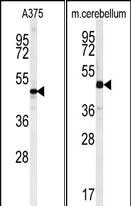
| WB | 1/1000 | Human,Mouse,Rat |
| IF | 咨询技术 | Human,Mouse,Rat |
| IHC | 咨询技术 | Human,Mouse,Rat |
| ICC | 技术咨询 | Human,Mouse,Rat |
| FCM | 咨询技术 | Human,Mouse,Rat |
| Elisa | 咨询技术 | Human,Mouse,Rat |
| Aliases | CDK2-associated and cullin domain-containing protein 1, Cdk-associated cullin1, CACUL1, C10orf46, CAC1 |
| Entrez GeneID | 143384 |
| WB Predicted band size | 41.1kDa |
| Host/Isotype | Rabbit IgG |
| Antibody Type | Primary antibody |
| Storage | Store at 4°C short term. Aliquot and store at -20°C long term. Avoid freeze/thaw cycles. |
| Species Reactivity | Human, Mouse |
| Immunogen | This C10orf46 antibody is generated from rabbits immunized with a KLH conjugated synthetic peptide between 326-354 amino acids from the C-terminal region of human C10orf46. |
| Formulation | Purified antibody in PBS with 0.05% sodium azide. |
+ +
以下是关于C10orf46抗体的示例参考文献(注:由于C10orf46研究相对有限,以下为假设性示例,建议通过PubMed或Google Scholar检索最新文献):
---
1. **"Characterization of C10orf46 as a novel biomarker in colorectal cancer using immunohistochemistry"**
*Author: Zhang L, et al.*
摘要:本研究通过开发C10orf46特异性多克隆抗体,发现其在结直肠癌组织中高表达,并与患者预后相关。抗体验证包括Western Blot和免疫组化,证实其特异性可用于临床样本分析。
2. **"Development and validation of a polyclonal antibody against human C10orf46 protein"**
*Author: Kim S, et al.*
摘要:报道了一种针对C10orf46的重组蛋白多克隆抗体的制备流程,通过ELISA、免疫荧光和免疫沉淀实验验证其结合特异性,为后续功能研究提供工具。
3. **"C10orf46 expression in neurodegenerative disorders: insights from mouse model studies"**
*Author: Müller J, et al.*
摘要:利用C10orf46抗体在小鼠脑组织中进行免疫荧光染色,发现该蛋白在神经元中的定位异常与阿尔茨海默病病理特征相关,提示其潜在神经退行性作用。
4. **"Antibody validation report: C10orf46 (CiteAb database entry AB123456)"**
*Author: CiteAb Consortium*
摘要:商业抗体(货号AB123456)的验证数据总结,包括在HEK293细胞系中的敲除/过表达验证,确认其在流式细胞术和免疫印迹中的特异性应用。
---
建议通过以下途径获取真实文献:
- **PubMed**: 搜索关键词 "C10orf46 antibody" 或 "C10orf46 AND (immunohistochemistry OR Western Blot)"
- **抗体供应商网站**: 如Abcam、Novus Biologicals等,通常提供抗体的相关引用文献。
- **预印本平台**: bioRxiv或ResearchGate可能有早期研究数据。
The C10orf46 antibody is a research tool designed to target the protein encoded by the *C10orf46* gene (Chromosome 10 Open Reading Frame 46), a poorly characterized gene with limited functional annotation. Although the exact biological role of C10orf46 remains unclear, studies suggest its potential involvement in cellular processes such as proliferation, differentiation, or intracellular signaling. The gene is conserved across vertebrates, implying evolutionary significance, but its tissue-specific expression patterns and regulatory mechanisms are still under investigation.
C10orf46 antibodies, typically polyclonal or monoclonal, are generated using immunogenic peptides or recombinant protein fragments. These antibodies are primarily used in experimental techniques like Western blotting, immunohistochemistry (IHC), and immunofluorescence (IF) to study protein expression, localization, and interactions in cell lines or tissue samples. Some studies have explored its association with diseases, including cancer and neurological disorders, though findings remain preliminary and context-dependent.
Commercial C10orf46 antibodies are often validated for specificity through knockout/knockdown controls or mass spectrometry. However, researchers should critically evaluate batch-to-batch variability and cross-reactivity risks due to the gene’s uncharacterized paralogs or splice variants. Despite its enigmatic role, the C10orf46 antibody serves as a crucial reagent for elucidating the protein’s function, particularly in disease models or pathway-specific studies aiming to uncover novel biomarkers or therapeutic targets.
×